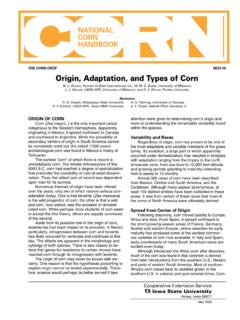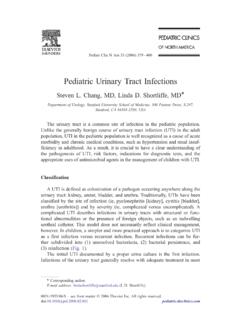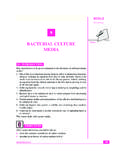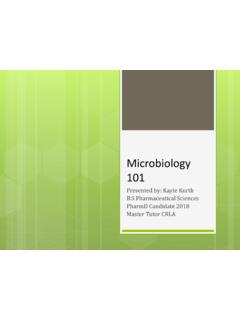Transcription of ANNEX Preparation of Media and Reagents
1 1 ANNEX Preparation of Media and Reagents Quality control (QC) of Media Each batch of Media prepared in the laboratory and each new manufacturer s lot number of Media should be tested using appropriate QC reference strains for sterility, the ability to support growth of the target organism(s), and/or the ability to produce proper biochemical reactions. A QC record should be maintained for all Media prepared in the laboratory and purchased commercially; including Preparation or purchase date and QC test results. Any unusual characteristic of the medium, such as color or texture, or slow growth of reference strains should be noted. I. Routine agar and broth Media All agar Media should be aseptically prepared and dispensed into 15x100 mm Petri dishes (15-20 ml per dish).
2 After pouring, the plates should be kept at room temperature (25 C) for several hours to prevent excess condensation from forming on the covers of the dishes. For optimal growth, the plates should be placed in a sterile plastic bag and stored in an inverted position at 4 C until use. All broth Media should be stored in an appropriate container at 4 C until use. A. Blood agar plate (BAP): trypticase soy agar (TSA) + 5% sheep blood A BAP is used as a general blood agar medium. It is used for growth and testing of N. meningitidis and S. pneumoniae. The plate should appear a bright red color. If the plates appear dark red, they are either old or the blood was likely added when the agar was too hot.
3 If so, the Media should be discarded and a new batch should be prepared. Media Preparation 1. Prepare the volume of TSA needed in a flask according to the instructions given on the label of the dehydrated powder. It is convenient to prepare 500 ml of molten agar in a l -2 liter flask. If TSA broth powder is used, add 20 g agar into 500 ml of distilled water. The Media should be heated and fully dissolved with no powder on the walls of the vessel before autoclaving. 2. Autoclave at 121 C for 20 minutes. 3. Cool to 60 C in a water bath. 4. Add 5% sterile, defibrinated sheep blood (5 ml sheep blood can be added to 100 ml of agar). 2 If a different volume of basal medium is prepared, the amount of blood added must be adjusted accordingly to 5% ( , 50 ml of blood per liter of medium).
4 Do NOT use human blood. 5. Dispense 20 ml into 15x100 mm Petri dishes. Allow the Media to solidify and condensation to dry. 6. Place the plates in sterile plastic bags and store at 4 C until use. Quality control 1. Grow a S. pneumoniae or an N. meningitidis QC strain for 18-24 hours on a BAP at 35-37 C with ~5% CO2 (or in a candle-jar). 2. Observe the BAP for specific colony morphology and hemolysis. 3. As a sterility test, incubate an uninoculated plate for 48 hours at 35-37 C with ~5% CO2 (or in a candle-jar). Passing result: S. pneumoniae should appear as small, grey to grey-green colonies surrounded by a distinct green halo (alpha-hemolysis).
5 N. meningitidis should appear as large, round, smooth, moist, glistening, and convex, grey colonies with a clearly defined edge on the BAP. After 48 hours, the sterility test plate should remain clear. B. Blood culture broth Blood culture medium is used to grow N. meningitidis, S. pneumoniae, and H. influenzae. Media Preparation 1. Follow the manufacturer s instructions on the label of each bottle of dehydrated trypticase soy broth (TSB). 2. Add g sodium polyanetholsulfonate (SPS) per liter of medium. SPS is especially important for recovery of H. influenzae. 3. Dispense in 20 ml (for a pediatric blood culture bottle) and 50 ml (for an adult blood culture bottle) amounts into suitable containers (tubes or bottles) with screw-caps with rubber diaphragms.
6 The amount of liquid in the containers should make up at least two-thirds of the total volume of the container. 3 4. Autoclave at 121 C for 15 minutes. 5. Allow to cool and store medium at room temperature (25 C). Quality control 1. Grow N. meningitidis, S. pneumoniae, and H. influenzae QC strains for 18-24 hours on a BAP or CAP at 35-37 C with ~5% CO2 (or in a candle-jar). 2. Add 1-3 ml of sterile rabbit, horse, or human blood to 3 bottles of freshly prepared blood culture Media . 3. Collect a loopful of overnight growth from each of the plates of bacteria and suspend it in 1-2 ml of blood culture broth (a different organism for each bottle). 4.
7 Inoculate the bacterial suspensions into the 3 blood culture bottles. 5. Incubate the blood culture bottles at 35-37 C with ~5% CO2 (or in a candle-jar) for up to 7 days and observe for growth. 6. Subculture bacteria onto appropriate Media at 14 hours and 48 hours. 7. As a sterility test, incubate an uninoculated blood culture bottle for 48 hours at 35-37 C with ~5% CO2 (or in a candle-jar). Passing result: All three bacteria should be recovered on appropriate Media after 24 and 48 hours. After 48 hours, the sterility test plate should remain clear. C. Chocolate agar plate (CAP) CAP is a medium that supports the special growth requirements (hemin and NAD) needed for the isolation of fastidious organisms, such as H.
8 Influenzae, when incubated at 35-37 C in a 5% CO2 atmosphere. CAP has a reduced concentration of agar, which increases the moisture content of the medium. It can be prepared with heat-lysed horse blood, which is a good source of both hemin and NAD, although sheep blood can also be used. Growth occurs on a CAP because NAD is released from the blood during the heating process of chocolate agar Preparation (the heating process also inactivates growth inhibitors) and hemin is available from non-hemolyzed as well as hemolyzed blood cells. 4 Media Preparation 1. Heat-lyse a volume of horse or sheep blood that is 5% of the total volume of Media being prepared very slowly to 56 C in a water bath.
9 2. Dispense 20 ml into 15x100 mm Petri dishes. Allow the Media to solidify and condensation to dry. 3. Place the plates in sterile plastic bags and store at 4 C until use. 4. As a sterility test, incubate an uninoculated plate for 48 hours at 35-37 C with ~5% CO2 (or in a candle-jar). Quality control 1. Grow N. meningitidis, S. pneumoniae, and H. influenzae QC strains for 18-24 hours on a CAP at 35-37 C with ~5% CO2 (or in a candle-jar). 2. Observe the CAP for specific colony morphology and hemolysis. Passing result: N. meningitidis and H. influenzae should appear as large, round, smooth, convex, colorless-to-grey, opaque colonies on the CAP with no discoloration of the medium.
10 S. pneumoniae should appear as small grey to green colonies with a zone of alpha-hemolysis (only slightly green) on the CAP. After 48 hours, the sterility test plate should remain clear. D. CAP with bacitracin CAP with bacitracin is a selective medium used to improve the primary isolation of H. influenzae from specimens containing a mixed flora of bacteria and/or fungi. Media Preparation 1. Prepare double strength TSA (20 g into 250 ml distilled water) as the basal medium. 2. Autoclave at 121 C for 20 minutes. 3. Cool to 50 C in a water bath. Use a thermometer to verify the temperature in the water bath. 4. Prepare a solution of 2% hemoglobin (5 g in 250 ml distilled water).
















